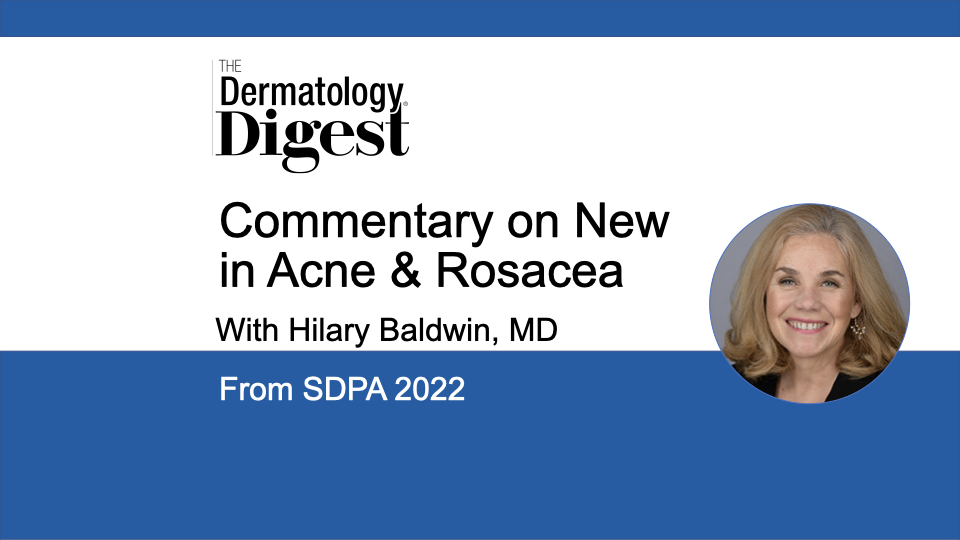Dr. Hilary Baldwin offers several tips for optimally treating acne and rosacea for new and experienced providers, alike.

Hilary Baldwin, MD, Medical Director, Acne Treatment and Research Center, Brooklyn, New York
Rosacea: Tip 1
“Let’s start with rosacea, since we always start with acne. If I had one tip to give on rosacea, regardless of your level of expertise, it’s to make sure that you’re listening to your patient. I know that sounds silly. It sounds trite. But it’s something that we don’t often do,” said Hilary Baldwin, MD, who gave two talks, one foundational and the other on what’s new in acne and rosacea at the Society of Dermatology Physician Assistants (SDPA) 20th Annual Fall Dermatology Conference in Miami, Florida.
According to Dr. Baldwin, she hands the patient a mirror and has them on as she points out the salient features of rosacea.
“Then, we can go on to discuss which [areas] they want to treat (because they don’t always want to treat all of them), and how we’re going to go about doing it.”
Tip 2
Be sure to use the new classification of rosacea, which is phenotypic, rather than the old subtype distribution, where dermatologists would try to categorize rosacea patients into either having vascular or papulopustular types, said Dr. Baldwin.
“Our patients more often have combination disease. By looking at them carefully and by listening, you will have figured that out and you can pick and choose treatments that are specifically for the features that patient has.”
Tip 3
Whenever possible, use the newer topicals, said Dr. Baldwin.
“The topical treatments that are a little older, like azelaic acid and metronidazole, are not quite as effective as our newer topicals, ivermectin (Soolantra, Galderma), microencapsulated benzyl peroxide (Epsolay, Galderma), and minocycline.”
Dr. Baldwin said she only uses azelaic acid or metronidazole if insurance refuses to pay for one of the others.
Tip 4
Don’t’ forget isotretinoin for rosacea, said Dr. Baldwin.
“It’s an excellent treatment for the disease. It treats erythema, phymas, papules, and pustules. The only downside is you still have to use iPledge, and this is a chronic disorder that is not cured by isotretinoin, but it does a heck of a job controlling it.”
Acne: Tip 1
Like with rosacea, make sure you’re discussing and listening to your patient. But this time focus on what the patient’s life is like, said Dr. Baldwin.
“… take a teenage boy, for example. If you prescribe a bunch of drugs in the morning, and you don’t realize he plays football and wears heavy garb, which is rubbing on his back and increasing his problem, you’re going to prescribe a whole bunch of things to this guy that he’s never going to use.”
Tip 2
Always use a topical retinoid, regardless of what type of acne patients have or how old they are, said Dr. Baldwin.
“Most of us in the acne mafia say, ‘retinoids from birth to death,’ and I’m one of those.”
“Retinoids are comedone busters. They get rid of the comedones you have but also prevent the development of new lesions. It’s truly a situation where you’re using the drug today to prevent problems down the line.”
Tip 3
Same for benzyl peroxide, said Dr. Baldwin.
“It may be 60 years old, but I can’t practice without it. We’re using [benzyl peroxide] for two things. One is to make the acne better; the other is to prevent the development of resistant organisms.”
“We don’t know why but for some reason using it along with topical or oral antibiotics reduces the risk of developing resistance.”
Tip 4
There are lots of new drugs for acne—9 that have come to market in the last 5 or 6 years, said Dr. Baldwin.
“Our acne toolbox is totally filled with all sorts of wonderful drugs that can really make our patients better, especially when used in combination.”
With the addition of topical clascoterone (Winlevi, Sun Dermatology), dermatologists finally have a topical anti-sebum drug, said Dr. Baldwin.
“So, we can with only topical agents reduce all four pillars of acne pathogenesis: killing Cutibacterium acnes (C. acnes), reducing sebum, unclogging the pores, and reducing inflammation. We can really coddle together a combination of medications that will hit all four pillars, which is considerably new for us.”
Tip 5
Soon (depending on FDA approval), dermatologists should have access to a new mediation that is the first triple topical combination, said Dr. Baldwin.
“It has been shown to be more effective than all the duads. It’s adapalene, benzyl peroxide, and clindamycin together in one container. I’ve been waiting for this for an awfully long time.”
Disclosures: Dr. Baldwin is an advisor and/or speaker for Galderma, Bausch, Almirall, Sun, Journey, and EPI.


